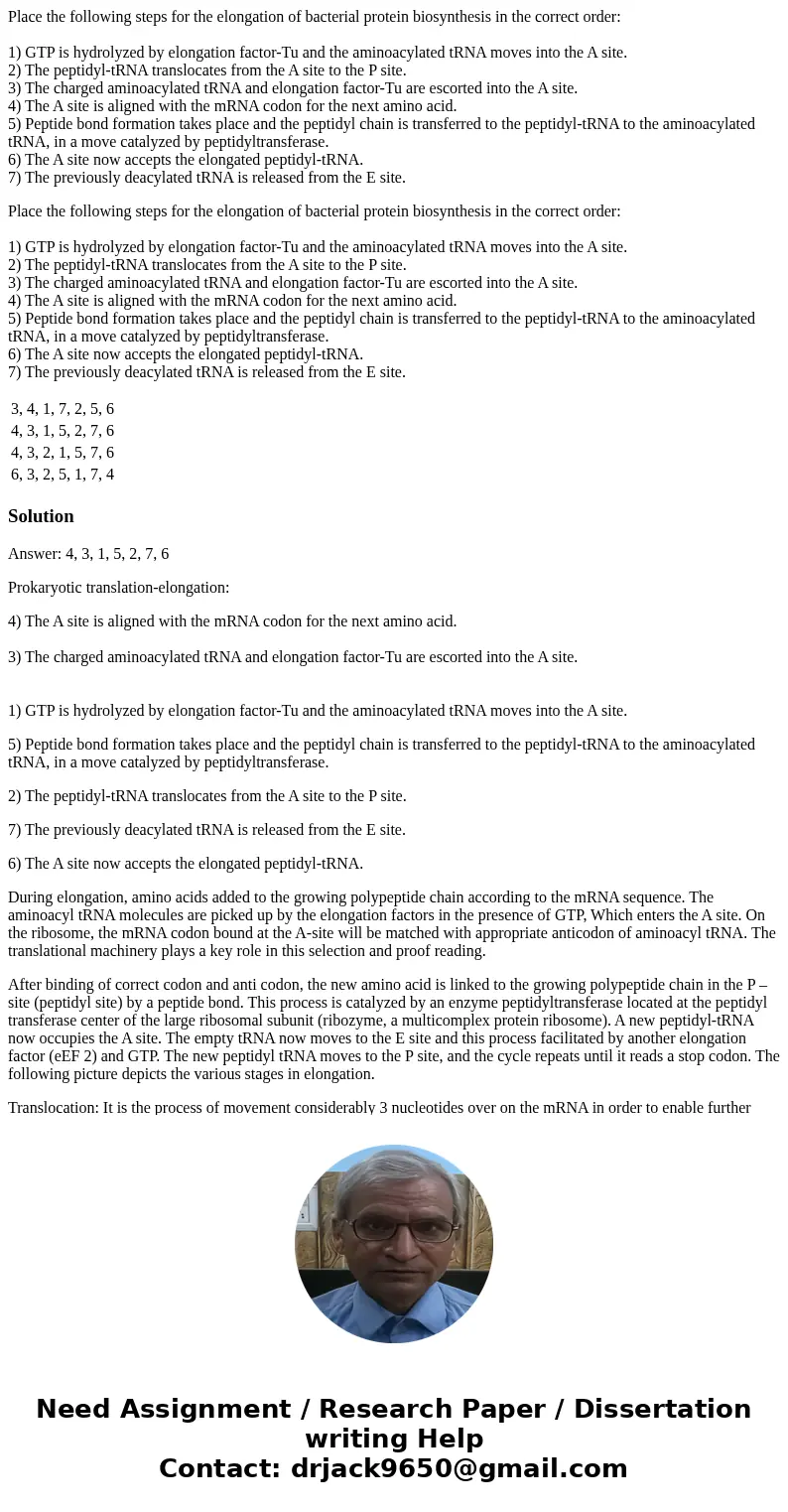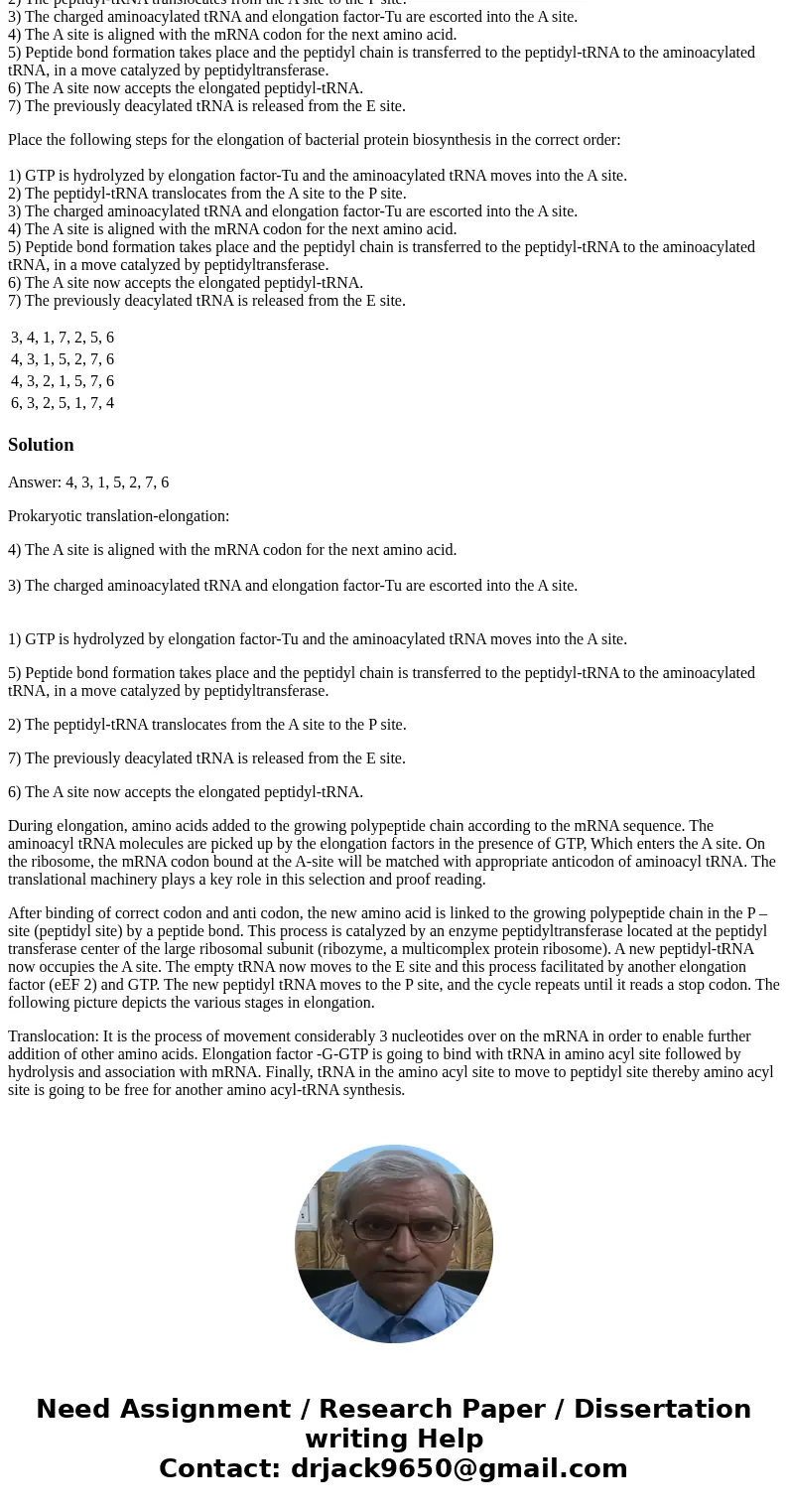Place the following steps for the elongation of bacterial pr
Place the following steps for the elongation of bacterial protein biosynthesis in the correct order:
1) GTP is hydrolyzed by elongation factor-Tu and the aminoacylated tRNA moves into the A site.
2) The peptidyl-tRNA translocates from the A site to the P site.
3) The charged aminoacylated tRNA and elongation factor-Tu are escorted into the A site.
4) The A site is aligned with the mRNA codon for the next amino acid.
5) Peptide bond formation takes place and the peptidyl chain is transferred to the peptidyl-tRNA to the aminoacylated tRNA, in a move catalyzed by peptidyltransferase.
6) The A site now accepts the elongated peptidyl-tRNA.
7) The previously deacylated tRNA is released from the E site.
Place the following steps for the elongation of bacterial protein biosynthesis in the correct order:
1) GTP is hydrolyzed by elongation factor-Tu and the aminoacylated tRNA moves into the A site.
2) The peptidyl-tRNA translocates from the A site to the P site.
3) The charged aminoacylated tRNA and elongation factor-Tu are escorted into the A site.
4) The A site is aligned with the mRNA codon for the next amino acid.
5) Peptide bond formation takes place and the peptidyl chain is transferred to the peptidyl-tRNA to the aminoacylated tRNA, in a move catalyzed by peptidyltransferase.
6) The A site now accepts the elongated peptidyl-tRNA.
7) The previously deacylated tRNA is released from the E site.
| 3, 4, 1, 7, 2, 5, 6 |
| 4, 3, 1, 5, 2, 7, 6 |
| 4, 3, 2, 1, 5, 7, 6 |
| 6, 3, 2, 5, 1, 7, 4 |
Solution
Answer: 4, 3, 1, 5, 2, 7, 6
Prokaryotic translation-elongation:
4) The A site is aligned with the mRNA codon for the next amino acid.
3) The charged aminoacylated tRNA and elongation factor-Tu are escorted into the A site.
1) GTP is hydrolyzed by elongation factor-Tu and the aminoacylated tRNA moves into the A site.
5) Peptide bond formation takes place and the peptidyl chain is transferred to the peptidyl-tRNA to the aminoacylated tRNA, in a move catalyzed by peptidyltransferase.
2) The peptidyl-tRNA translocates from the A site to the P site.
7) The previously deacylated tRNA is released from the E site.
6) The A site now accepts the elongated peptidyl-tRNA.
During elongation, amino acids added to the growing polypeptide chain according to the mRNA sequence. The aminoacyl tRNA molecules are picked up by the elongation factors in the presence of GTP, Which enters the A site. On the ribosome, the mRNA codon bound at the A-site will be matched with appropriate anticodon of aminoacyl tRNA. The translational machinery plays a key role in this selection and proof reading.
After binding of correct codon and anti codon, the new amino acid is linked to the growing polypeptide chain in the P –site (peptidyl site) by a peptide bond. This process is catalyzed by an enzyme peptidyltransferase located at the peptidyl transferase center of the large ribosomal subunit (ribozyme, a multicomplex protein ribosome). A new peptidyl-tRNA now occupies the A site. The empty tRNA now moves to the E site and this process facilitated by another elongation factor (eEF 2) and GTP. The new peptidyl tRNA moves to the P site, and the cycle repeats until it reads a stop codon. The following picture depicts the various stages in elongation.
Translocation: It is the process of movement considerably 3 nucleotides over on the mRNA in order to enable further addition of other amino acids. Elongation factor -G-GTP is going to bind with tRNA in amino acyl site followed by hydrolysis and association with mRNA. Finally, tRNA in the amino acyl site to move to peptidyl site thereby amino acyl site is going to be free for another amino acyl-tRNA synthesis.


 Homework Sourse
Homework Sourse